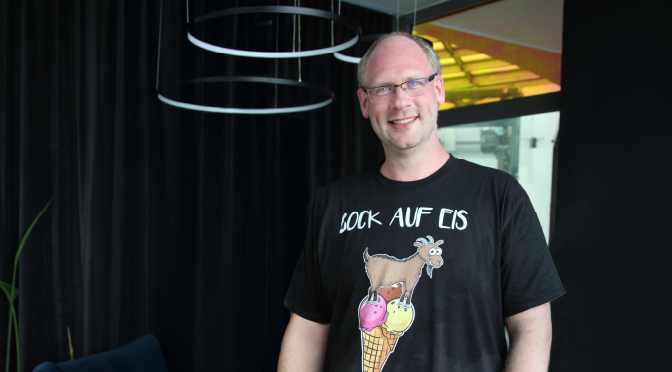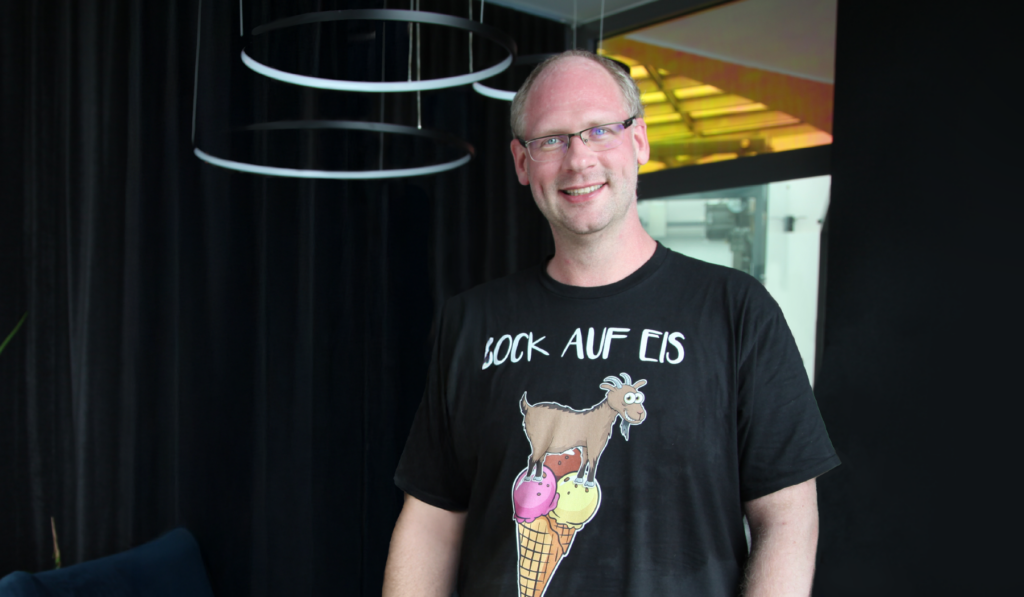Paul’s story is a mixture of passion, career changes and his pursuit of perfection – whether in his job or in his extraordinary hobby of ice cream making.
From the perfect steak to the perfect ice cream
When Paul started working in order management at Telematica (part of ANX Holding GmbH, which also includes Anexia), nobody would have thought that he would one day become a desserts craftsman for his friends and colleagues. What started as a challenge to make the perfect steak turned into a mission to make the perfect ice cream. “I already mastered the steak – now I needed a new challenge,” Paul tells us in the interview.
His journey into frozen treats began with frustration: supermarket standards like chocolate, vanilla or strawberry just didn’t cut it. “I never really found my favorite – something like yogurt, coconut, marzipan or after-eight…” So, at the beginning of the year, he bought a small household machine and started experimenting. The first attempts were promising, but not yet perfect: “At first it’s nice and soft (-6°C), but after freezing to -18°C, it turned into a brick.”
But Paul was not letting this scare him off. The process of making ice cream, as Paul describes it, is much more than just mixing ingredients – it is a science that requires a lot of patience and precision – it is exactly this patience and precision that runs like a red line through Paul’s life, both in his profession and in his hobby.
The Right Ingredients, the Right Tools
Everything starts with choosing the right ingredients. Paul values high-quality, natural raw materials: “I want to stick to my line. Nothing is changed. This is the recipe that is produced accordingly.” He specifically avoids cheap substitutes, flavorings and colorings or pre-made ice cream mixes and only uses ingredients such as high-quality fruit and nut purees and dairy products. One example of this is his pistachio ice cream, which he only makes with 100% pistachio puree instead of using sweetened pistachio creams.
Once the ingredients have been selected, the real art begins: weighing, mixing and adjusting. The process of balancing – the careful ratio of water, fat, sugar, and dry ingredients – defines the final texture. “Only the right combination leads to perfection,” he says. “I use the cheap website app eisapp24.de for balancing.”
Paul applies the same care and precision here as he does in his job. Patience and precision are also crucial in order management at Telematica. Customer inquiries and queries require him to maintain an overview and take care of every detail. “You have to be patient and take your time,” he says. He transfers this quality directly to ice cream production.
The manufacturing process: sugar, heat, cold and technology
The choice of sugar is crucial in ice cream making, as it affects not only the taste but also the texture and freezing point. Paul uses various sugars like sucrose (table sugar), glucose, and dextrose (grape sugar). Each has a different sweetening power and effect on freezing. “Household sugar has a sweetening strength of 100 and an anti-freezing value of 100. Dextrose has a sweetening strength of 70 but an anti-freezing value of 190, making the ice cream softer but less sweet,” he explains. These values influence whether the final product is creamy or firm.
Equally important are binding substances, which reduce ice crystal formation and create a smoother texture. Paul adds small amounts of locust bean gum and guar gum to the mixture. “This maturing process binds water and fat, resulting in smoother ice cream,” he says.
After mixing and weighing the ingredients, the base is heated. For milk-based ice cream, the mixture is brought to 82 °C for 30 seconds. This step eliminates bacteria and helps ingredients blend properly: sugars dissolve, proteins bind, stabilizers swell, fats melt, and emulsifiers ensure a uniform, creamy base—the foundation of perfect ice cream.
Paul goes even further with chocolate ice cream: “I heat chocolate ice cream to at least 92 degrees because the full cocoa flavor only develops at this temperature.” After heating, the mixture is cooled as quickly as possible (ice bath/food processor) before being left to chill in the fridge for between 2 and 6 hours, depending on the type of ice cream. Finally, the mixture is placed in the ice cream maker, where it freezes with constant stirring. This also incorporates air into the ice cream, which makes it light and creamy. “Of course air gets in through the ice cream machine, but never as much as in the industry,” Paul emphasizes. He attaches great importance to ensuring that his ice creams have a natural, thick consistency.
Patience, passion and creative varieties
What sets Paul apart is his patience and willingness to refine. “Some recipes I’ve revised seven times – they were too fatty, too sweet, or just not quite right.” With over 30 creations under his belt, he’s always open to new ideas. Unusual examples include semolina (developed for a friend in Grießgasse, Graz), orange Aperol, or a fresh lemon variety. “Try the lemon in Prosecco – it’s a real treat,” he laughs.
Looking Ahead
With his project “Bock auf Eis,” Paul dreams of becoming the “Ice King of Graz” one day, he says with a wink. Until then, his lovingly handcrafted treats continue to surprise and delight friends and coworkers alike – because every scoop is uniquely his.

